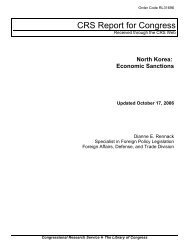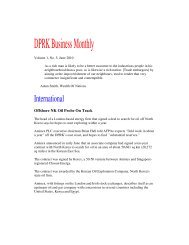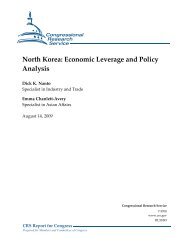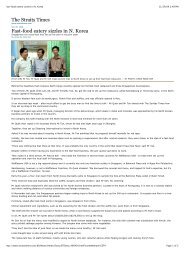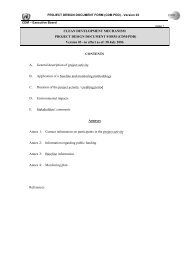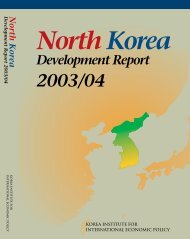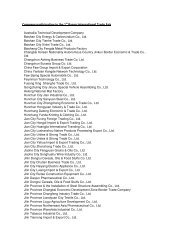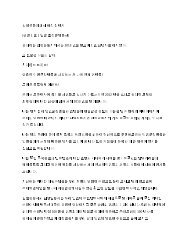North Korean Policy Elites - Defense Technical Information Center
North Korean Policy Elites - Defense Technical Information Center
North Korean Policy Elites - Defense Technical Information Center
Create successful ePaper yourself
Turn your PDF publications into a flip-book with our unique Google optimized e-Paper software.
guess is that anyone who rises in the <strong>North</strong> <strong>Korean</strong> hierarchy is adept at reading the mind of his<br />
superiors, although the mercurial Kim can be a tough person to predict. Even when people are<br />
careful to consider Kim’s likely preferences, they still face the danger that a recommendation<br />
seemingly consistent with Kim’s current thinking may be branded “counter-revolutionary” if<br />
Kim changes his mind at a later date. Consider the cases of Kim Dal-hyon and Kim Chong-u. 30<br />
This dilemma of creativity vs. orthodoxy critically undermines Kim Jong-il’s call for “new<br />
thinking.” 31<br />
E. DOMESTIC NEWS SOURCES<br />
What roles do different kinds of communications play in <strong>North</strong> <strong>Korean</strong> society? What<br />
role would Kim like them to play in order to achieve his goal of making society into a<br />
homogenous “socio-political organism,” with the leader as the “nerve center”? How can<br />
communications contribute to social stability and at the same time promote adaptations to a<br />
changing world? Models and theories of communication raise many interesting and important<br />
questions about <strong>North</strong> <strong>Korean</strong> communication patterns, suggesting future lines of research.<br />
For example, systems theorists are fond of pointing out that closed systems, which do not<br />
communicate with the environment, inevitably die. 32 Open systems live, but at the risk of<br />
becoming destabilized by their environment. How will the Kim regime resolve this dilemma?<br />
Organizations tend to employ an information search process matching the perceived<br />
degree of ambiguity of the environment. 33 An unambiguous environment can be scanned with a<br />
simple search mechanism (e.g., a few clerks assigned to the environmental monitoring function),<br />
whereas a complex, ambiguous environment requires that the organization employ more<br />
30 Kim Dal-hyon, who appeared to be the champion of <strong>North</strong> Korea’s economic modernization in the early 1990s,<br />
rose to the posts of State External Economic Affairs chairman and deputy prime minister. He led a delegation to<br />
South Korea in 1992, but later was abruptly demoted to a local economic position from which he never made a<br />
comeback. He is believed to have died in 2000. Yonhap News Agency, <strong>North</strong> Korea Handbook. Armonk, NY: M.<br />
E. Sharpe, 2003, p. 830. Later in the 1990s, Kim Chong-u, the top <strong>North</strong> <strong>Korean</strong> official in charge of external<br />
economic affairs, failed to appear at a November 1997 economic conference. It is rumored he was banished to the<br />
countryside. A number of other top external economic officials disappeared at about the same time. Chosun Ilbo,<br />
December 28, 2001. FBIS KPP20011228000015.<br />
31 Expanding on the New Year’s editorial, one of the major statements of Kim Jong-il’s “new economic thinking”<br />
campaign in early 2001 instructs that “With innovative insight, functionaries should meditate on and examine<br />
their overall tasks anew . . . .” At the same time, they should do everything “in line with the great Comrade Kim<br />
Jong-il’s intent.” That is to say, be creative in the way that you think Kim wants you to be creative. Nodong<br />
Sinmun editorial, January 4, 2001. Broadcast on KCBS on the same date. FBIS KPP20010104000042.<br />
32 A readable overview of communications theory, including the systems approach, is Dominic A. Infante, Andrew<br />
S. Rancer, and Deanna F. Womack. Building Communication Theory. Prospect Heights, IL: Waveland Press,<br />
2003. Another good source is Stephen W. Littlejohn. Theories of Human Communication. Belmont, CA:<br />
Wadsworth, 2002.<br />
33 This is the “principle of requisite variety,” a part of “organizational information theory.” The original source is<br />
Karl Weick’s The Social Psychology of Organizing (2 nd ed.). Reading, MA: Addison-Wesley, 1979.<br />
III-12



